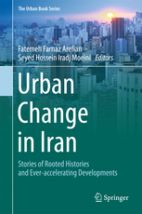Urban Change in Iran: Stories of Rooted Histories and Ever-accelerating Developments

This book focuses on socio-cultural aspects of urban transformations in Iranian cities. The content is mainly based on a selection of papers accepted for the conference “Urban Change in Iran”, hosted by the Bartlett Development Planning Unit of University College London.
The book is organized in five parts. The first part, “Pre-modern and contemporary urbanism”, deals with the historical context for urban transformation in Iran. The first chapter in this part examines the role of a specific type of water supply – the qanat system – in the formation of Iranian desert cities. The next chapter explores the Tehran Bazaar as a “non place”, followed by a chapter that through three examples of neighbourhoods in modern Tehran (Chaharsad-Dastgah, Narmak and Nazi-Abad) describes Iranian modernization in the period between 1945 and 1954. The last chapter in Part I reviews images of Tehran in Iranian post-revolutionary cinema, focusing on urban concerns.
The second part, “Contemporary Society and Culture”, deals with the interconnections between the society and city formation. The first chapter of this part uses concepts based on the Quran, focusing for instance on modesty in order to understand contemporary cities in the Islamic world. The following chapter explains the theme of spatial justice in Tehran. The last chapter presents a participatory visual method as a tool to foster public dialogue on energy and resource-efficient behaviour and urban development in the new town of Hashtgerd.
Part three, “Urban continuity or discontinuity”, asks how to achieve urban continuity while dealing with urban change. The first chapter in this part presents a framework to analyse the transformation of Tehran’s urban form during the Pahlavi monarchy between 1925 and 1979. The next chapter presents the case of Shushtar-e-No, a satellite city that represents a paradigmatic shift in the approach to housing. And the final chapter traces how social and economic factors, along with the process of modernization, have over the years contributed to destroying natural elements of Tehran.
Part four, “Shaping Iranian Cities (Zooming Out)”, addresses the broader context and influences on city formation and maintenance. The main aim of the first chapter is to examine the institutional and social capacities for moving and progressing towards sustainable urban development in Iran. The next chapter illustrates old and new emerging patterns of spatial inequality in Tehran, and also examines the theory of the “global city” between 1996 and 2006. The last chapter provides a historical analysis of morphological changes in housing in Tehran, as they have been constrained in each successive period in the city’s growth.
The last part, “Shaping Iranian Cities (Zooming In): Urban Projects and Programmes”, explores the roles of urban projects and programmes in urban transformation. The first chapters investigates the effects of Iran’s first baby boom after 1978 and looks at pressures of the baby boomer generation on housing; state solutions such as large-scale affordable housing projects “Maskan-e- Mehr” have failed to solve the problem as they focus on construction and not community building. The next chapter evaluates the reasons for the failure of state-led, large-scale property-led projects by critically discussing two case studies: one in Tehran and the other in Mashhad. The last chapter discusses organizing urban programmes as medium-scale organizational structures that pursue certain objectives within the challenging context of post-disaster urban reconstruction in Bam.
Book note prepared by Lina María Rosales
Search the Book notes database
Our Book notes database contains details and summaries of all the publications included in Book notes since 1993 - with details on how to obtain/download.
Use the search form above, or visit the Book notes landing page for more options and latest content.
For a searchable database for papers in Environment and Urbanization, go to http://eau.sagepub.com/

